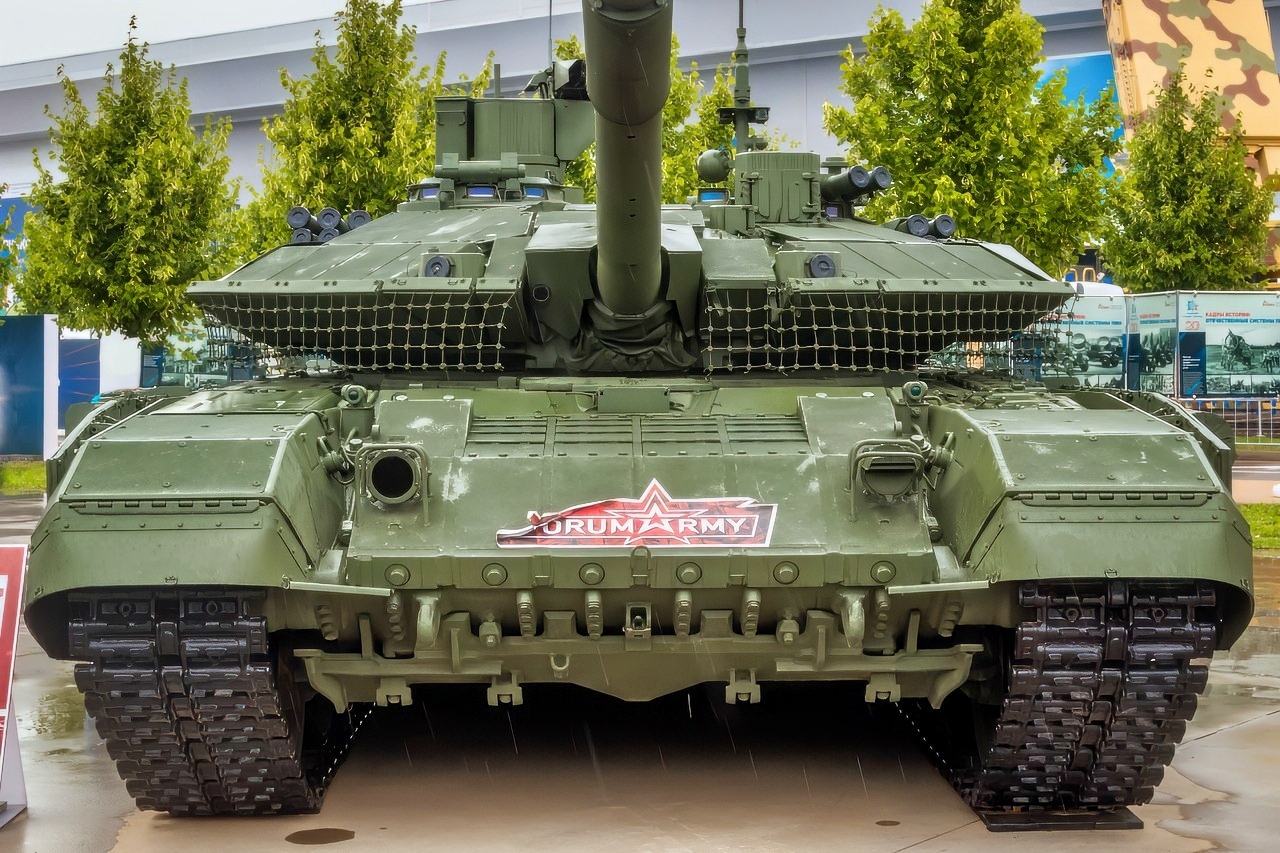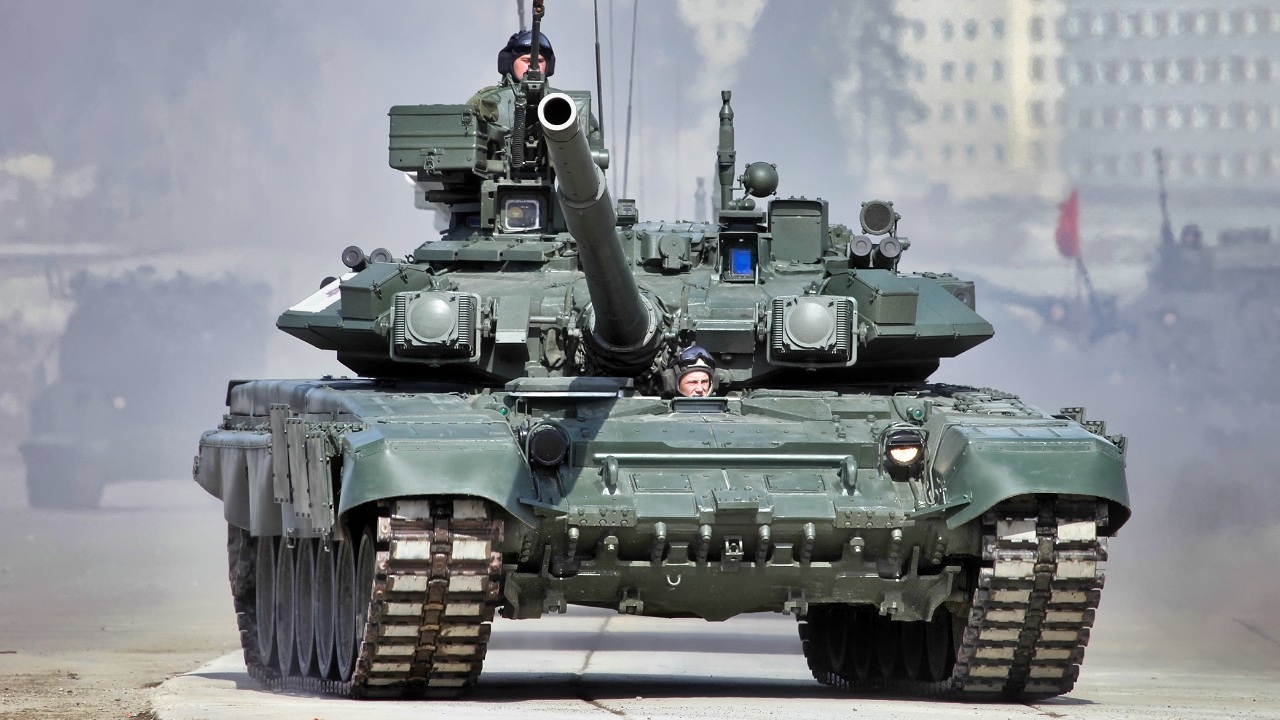Key Points and Summary – Russia’s T-90 main battle tank has underwhelmed in Ukraine.
-Its low profile comes from a three-man crew and autoloader, but the ammo carousel beneath the turret creates a lethal “jack-in-the-box” effect when penetrated—unlike NATO tanks with blow-out panels.

T-90M Russian Army. Image Credit: Creative Commons.
-Top-attack weapons like Javelin exploit thin turret armor, while even Carl Gustaf recoilless rifles have disabled T-90s. Battlefield clips show “disco head” turrets spinning uncontrollably, likely from electronics failures and inexperienced crews—issues worsened by sanctions.
-According to visually confirmed counts, roughly 200 T-90s across variants have been destroyed, damaged, abandoned, or captured, underscoring the tank’s mixed performance.
Russia’s T-90 Tank Keeps Blowing Its Top in Ukraine — Here’s Why
Thanks to advanced anti-armor weaponry—and a fatal design flaw—Russian tanks, including the T-90, have suffered hundreds of losses.
Russia’s T-90 main battle tank is among the most advanced tanks involved in the ongoing war in Ukraine.
Still, its performance has been lackluster, and its impact on the battlefield has been decidedly mixed, drawing both scrutiny and surprise from observers of that conflict.
Advanced Design and Vulnerability
The T-90, like most Soviet and Russian tank designs of the post-Second World War era, has a lower profile than its Western counterparts, a feature designed to present adversaries with a smaller target, thereby reducing the chances of being hit by other tanks or anti-tank teams.
This is achieved, in part, through the incorporation of an autoloading mechanism in place of a human loader, which gives the three-person tank an overall lower internal volume.
Unlike most Western tanks, however, the T-series of Soviet-turned-Russian tanks also stores main gun ammunition in a circular carousel below the crew. Tanks like the American M1 Abrams instead store ammunition in bustles around the turret, ammunition containers that incorporate blow-out paneling that directs the force of the explosion outwards, away from the crew compartment and away from the tank’s internals.
However, in pursuit of a small silhouette, the T-series designers made a significant compromise, one that sacrifices crew safety.
Should an enemy hit penetrate an M1 Abrams tank and ignite the tank’s ammunition, that subsequent explosion, though powerful, would be directed upward and out, leaving the crew relatively unscathed.
Not so in the T-90 and other T-series tanks in service with the Russian Army. Instead, those Russian tanks would experience a catastrophic explosion. Internal pressure builds until, as is often the case, the tank’s turret blows off the hull, completely destroying the tank.
This vulnerability has been dubbed the jack-in-the-box effect, due to similarities between the hand-cranked children’s toy “Jack” popping out of a box, and tank turrets launched sky-high in Ukraine.
The logic behind the M1 Abrams’ blow-out paneling is clear: while materiel losses on the battlefield, like main battle tanks, are unfortunate, they can be replaced as quickly as new platforms can be manufactured. A tank crew without a tank would, in theory, simply need a new tank to roll out and into combat.
But that same crew cannot be manufactured. High-quality crews for tanks, armored personnel carriers, ships, warplanes, and other vehicles must be carefully trained over the course of many months to meet basic qualifications, and then further honed and maintained to refine those skills. They are, in short, only very slowly replaceable.
One factor in the T-90’s lack of influence on the battlefields of Ukraine is the American-supplied FGM-148 Javelin anti-tank missiles, as well as similar munitions supplied by the United Kingdom, France, Germany, Poland, and other countries.
The Javelin and some of its counterparts within the NATO alliance follow a top-attack flight profile, which sees the Javelin’s warhead detonate not against the tank’s frontal armor, but instead against the top of the turret and an area where armor protection levels are typically thinnest.
However, the T-90s have also proven to be vulnerable to unguided munitions. Reports and online documentation indicate that weapons like the Carl Gustaf, a Swedish-designed 8.4cm recoilless rifle in service with the United States and numerous other countries worldwide, have been leveraged to disable or destroy T-90s and other Russian main battle tanks, as well as other vehicles. Similarly, other shorter-range, man-portable anti-vehicle weapons have also been developed.
Disco Head
In one malfunction seen multiple times in Ukraine, Russian T-90s have seemingly lost control of their turrets after sustaining hits of varying degrees of severity.
In one incident, American-supplied Bradley infantry fighting vehicles scored multiple hits on a Russian T-90, causing the tank’s turret to spin endlessly, completely out of sync with its crew or the threats it faced—a phenomenon that has been dubbed “disco head.”
Speaking to The Telegraph, a British newspaper, Hamish de Bretten-Gordon, formerly a tank commander in the British Army, explained that “inexperienced crews and poor electronics” were likely to be blamed for the unusual occurrence.
“It’s very easy for inexperienced people to become very disoriented in a tank because a tank’s hull can move in one direction, the turret could be in another direction and the commander’s sight could be in a completely other direction, which is why we get the term ‘disco head’ because people can easily become disoriented and the tank spins out of control,” Mr. de Bretten-Gordon explained.
“It could also be an electronics failure. Western tanks have a quite sophisticated fire control system, and the Russians don’t appear to have got it right.” But, he added, “I cannot say definitively, but some of the electronics in a T-90 are from Western sources, so sanctions are likely to exacerbate the situation.”
Regardless of whether the blame lies with inexperienced and undertrained Russian tanker crews, a shortage of electronic components for the T-90, or some as yet unidentified design flaw, the effect is the same.
Oryx, a website that documents visually confirmed losses on both sides of the Russo-Ukrainian War, also keeps track of T-90 losses.
The totals for the four T-90 variants Oryx lists as destroyed, damaged, abandoned, or captured number nearly 200.
About the Author: Caleb Larson
Caleb Larson is an American multiformat journalist based in Berlin, Germany. His work covers the intersection of conflict and society, focusing on American foreign policy and European security. He has reported from Germany, Russia, and the United States. Most recently, he covered the war in Ukraine, reporting extensively on the war’s shifting battle lines from Donbas and writing on the war’s civilian and humanitarian toll. Previously, he worked as a Defense Reporter for POLITICO Europe. You can follow his latest work on X.
More Military
Russia’s T-72 Tank Is So Obsolete
China Says It Can Kill B-21 Raider Bomber
3 Planes Canada Could Choose to Replace the F-35
